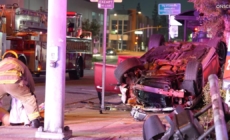-
Millie Bobby Brown Turns Heads With New Look at SAG Awards - 11 mins ago
-
Alex Rodriguez delivers in the clutch again, hitting $10K half-court shot for fan - 13 mins ago
-
Pope Francis ‘condition remains critical’ - 44 mins ago
-
How to Watch Thunder vs Timberwolves: Live Stream NBA, TV Channel - 55 mins ago
-
USWNT secures spot in SheBelieves Cup final with 2-1 win over Australia - 57 mins ago
-
Kyle Busch Launches Scathing Attack Of NASCAR Rival In Heated Atlanta Radio Message - 2 hours ago
-
NASCAR Cup Series: Ambetter Health 400 Highlights | NASCAR on FOX - 2 hours ago
-
Lindsay Lohan’s father Michael Lohan arrested on felony assault charge - 2 hours ago
-
After CHP pursuit, driver of stolen car hits another vehicle, kills pedestrian - 2 hours ago
-
SAG Awards 2025: Celebrities’ Red Carpet Fashion - 2 hours ago
Red Flag Warning for Nebraska in Aftermath of California Fires
Several counties across central Nebraska have been issued a “Red Flag Warning” due to the potential for wildfires.
Fires could break out across the Cornhusker State due to high winds and low humidity, which make for ideal wildfire weather.
This comes only weeks after much of Los Angeles was ablaze with many of the worst wildfires the city had ever seen.
“A Red Flag Warning means that critical fire weather conditions are either occurring now, or will shortly,” the NWS said in the warning.
“A combination of strong winds, low relative humidity, and warm temperatures can contribute to extreme fire behavior.”
ISTOCK / GETTY IMAGES PLUS / National Weather Service
Winds are expected to blow at speeds of between 15 to 20 mph, with some gusts of up to 30 mph in some regions. Humidity may drop as low as 16 percent.
“Any fire that develops will catch and spread quickly. Outdoor burning is not recommended,” the NWS said.
A Red Flag Warning has been issued for the counties in pink. The warning will be in effect from 12PM to 6PM. Near-critical fire weather conditions are expected for all counties not included in the warning. #kswx #newx pic.twitter.com/q6YTJV39jX
— NWS Hastings (@NWSHastings) January 27, 2025
This warning will stay in place between noon and 6 p.m. CST this evening.
Ideal conditions for wildfires typically involve a combination of high winds, low humidity and dry vegetation, as that makes it easier for fires to ignite, spread and grow uncontrollably.
Dry air dehydrates vegetation—making it more flammable—and warm weather speeds up this drying process and preheats vegetation, reducing the energy required to ignite it.
Wind feeds oxygen to the fire and pushes flames into new areas, causing rapid spread.
Winds like the Santa Anas in California can exacerbate fire conditions by drying out vegetation even further, which is exactly what occurred with the recent LA fires.
Red flag warnings like these blanketed much of Los Angeles over the past few weeks, and extended down to San Diego due to similar high winds and low humidity, with wildfires popping up nearly every day.
27 people across Los Angeles were killed in the Eaton and Palisades blazes—the two largest of the recent wildfires that destroyed over 12,000 structures, including much of the Pacific Palisades.
Over 100,000 people were forced to evacuate and over 27,000 acres were burned by these two fires alone.
The Eaton fire is now 98 percent contained, while the Palisades fire is 90 percent contained. The Hughes fire in Los Angeles, which burned over 10,000 acres and forced thousands to evacuate, is now 95 percent contained.
Another fire, named the Border 2 Fire, is burning just north of the Mexican border, having scorched some 6,625 acres. This fire is only 40 percent contained.
“Significant rain showers throughout the day led to a reduction of fire activity. With nearly a half inch of rain falling over the area, fire activity is now not expected to spread,” Cal Fire said in a status update.
Do you have a tip on a science story that Newsweek should be covering? Do you have a question about wildfires? Let us know via science@newsweek.com.
Source link






























